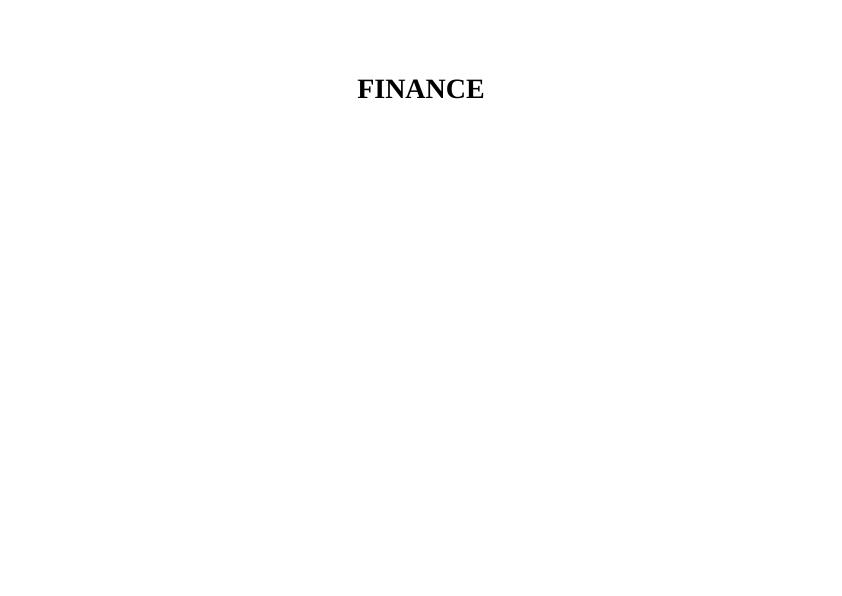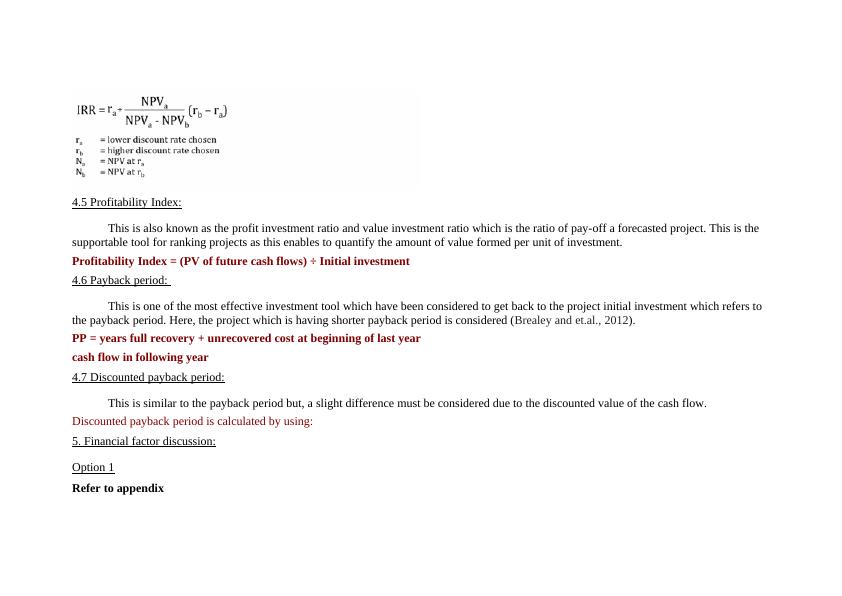FINANCE SCYCLES: 5 4.1 Company Objectives and Course of Action
21 Pages3997 Words292 Views
Added on 2020-07-22
About This Document
Analysis and evaluations of all investment scenario: 5 4.1 Net present value: 6 4.2 Accounting rate of return: 6 4.3 Internal Rate of Return: 6 4.5 Profitability Index: 7 4.6 Payback period: 7 4.7 Discounted payback period: 7 5. Non-financial factors appraisal discussion: 9 6.1Porter’s five forces: 9 6.3 SWOT Analysis: 10 6.4 PEST analysis: 10 6.3 Management appraisal control system: 11 6.4 Core Competencies, strategies focus and competitive advantages (Cheng et al., 2014).
FINANCE SCYCLES: 5 4.1 Company Objectives and Course of Action
Added on 2020-07-22
ShareRelated Documents
FINANCE

Contents1. EXECUTIVE SUMMARY...............................................................................................................................................................................................................52. INTRODUCTION..........................................................................................................................................................................................................................53. Company objectives and course of actions:...........................................................................................................................................................................54. Analysis and evaluations of all investment scenario:.............................................................................................................................................................54.1 Net present value:...............................................................................................................................................................................................................64.2 Accounting rate of return:...................................................................................................................................................................................................64.3 Internal Rate of Return:.......................................................................................................................................................................................................64.5 Profitability Index:................................................................................................................................................................................................................74.6 Payback period: ...................................................................................................................................................................................................................74.7 Discounted payback period:.................................................................................................................................................................................................75. Financial factor discussion:....................................................................................................................................................................................................7Option 1.....................................................................................................................................................................................................................................7Option 2.....................................................................................................................................................................................................................................8Option 3.....................................................................................................................................................................................................................................86. Non-financial factors discussion:...........................................................................................................................................................................................96.1Porter’s five forces:...............................................................................................................................................................................................................96.3 SWOT Analysis:..................................................................................................................................................................................................................106.4 PEST analysis:.....................................................................................................................................................................................................................106.3 Management accounting control system:..........................................................................................................................................................................116.4 Core Competencies, strategies focus and competitive advantages:..................................................................................................................................126.5Strategies Focus of the Coffee cups:...................................................................................................................................................................................126.6 Competitive advantage: ....................................................................................................................................................................................................12

6.7 Employee Benefits:............................................................................................................................................................................................................126.8 Synergies:...........................................................................................................................................................................................................................12CONCLUSION...............................................................................................................................................................................................................................13REFERENCES.................................................................................................................................................................................................................................14APENDIX ......................................................................................................................................................................................................................................15

1. EXECUTIVE SUMMARYThis report is made on Coffee Cups Ltd which is planning to expand their business operations by analysing industry in an effective manner. Coffee industry is at the peak level and also forecasted advanced growth in the next five years. The main drawback is that the business is small sized and there are hardly few players who operates at a grand level.2. INTRODUCTIONThis is the report which is made on the Coffee Cups Ltd. Which have various branches that can be gained into an effective manner. Now, there isa chance of gaining sustainable development. Now, coffee cups is planning to expand their operations throughout Europe. For that, they are planning to assess their business operations in an effective manner. The course of actions is to maximise the business operations in an effective manner. The coffee cups have been experienced into the growth, industry is dynamic and organisation requires to adopt its future positions and direction (Lamberton and Lapeyre, 2011).3. Company objectives and course of actions:Capital structure is the combination of the cost structure which contains equity and debts. However, this can be said that the capital structure is the one where firm finances its entire operations and emergence by implementing diverse sources of finances. Debt emergences form of bond issues payable, at the time when equity is categorised as equity stock, preference stock or retained earnings. Short-term debt like- working capital needs to likewise adopted to be part of the capital structure. Here, there are three options which have been mentioned (Föllmer and Schied, 2011).The main aim of the business is to estimate the business objectives efficiently. Now, there is a strong determination which can be converted into the business profits in an efficient manner. The main objectives of coffee cups are to: make the organisation into the most recognisable and most reputed brand in the Europe. Its does not aim only to sale the products but also to sell the CDs, t-shirts and diverse kinds of the games and stationery products. The main aim is to enhance the brand name, to optimise the return to its shareholders, and also to adopt expansion into with USA (Kotz, Kozubowski and Podgorski, 2012).Coffee cups opened up almost 200 new outlets during 2015 throughout Europe. Profits is presumed to be the main aim of the cited organisation. As this would reflect an efficient strategy which could help out to make an efficient strategy. 4. Analysis and evaluations of all investment scenario:Capital investment appraisal are likewise the capital budgeting which is mostly said that the planning process helps to identify the concerned organisation's investments, both long term and short term. The factors of the organisation which emerges under this types of capital investment

appraisal covers property, equipment, R&D projects, advertising campaign, advanced plants, advanced machinery and much more (Cheng, Ioannou and Serafeim, 2014).Capital investment appraisal factors which are selected based upon the priorities of the stakeholders and decision makers. This kind of selection of capital investment appraisal is entirely relied upon the long term growth If these compared to the short run. Investment appraisal techniques are those which helps to make the business operations effective and efficient (Finance and Network, 2013). This can be rightly said that various investment tools are used in order to know the project viability and then the business decisions can be taken. Here are some of the investment tools which would help out the organisation to take rational decisions appropriately.4.1 Net present value:This calculates the investment appraisal techniques which measures the cash inflow whether in negative or positive way. Whole capital investment appraisals have a single objective which reflects towards a positive NPV. As this is the mathematical calculation which covers present value of cash flow less the present value of cash outflow. This is the most effective tool through which project viability can be checked(Brooks, 2014). If the project showing negative NPV which simply means that the present value of net outflow is more than the present value of net inflow. Hence, the project does not be adopted. While on the other hand, if the present value of net outflow is less than the present value of cash inflows, then the refers that the NPV is negative and the project is considered.This is calculated by using: NPV = C x {(1 - (1 + R)-T) / R} − Initial Investment4.2 Accounting rate of return:Under this, the capital investment appraisal tools that helps to compares profits which could be earned by the concerned project to the amount of the initial investment capital which is needed for the project. Projects which could earn more rate of return which is naturally preferred over onesalong with the least rate of return. ARR is a non-discounted capital investment appraisal technique in that which does not consider the time valueof money covered (Embrechts, Klüppelberg and Mikosch, 2013). ARR is claculated by using: Average net profits/Average investment4.3 Internal Rate of Return:This is the point where the present value of cash outflow is equal to the present value of cash outflow. Here, NPV is zero. This is presumed to be the considered to calculate the efficiency of the capital investment. Henceforth, if the cost of capital investment is more than the IRR value, then in that case, project should be rejected. While on the other way, a low cost of capital has a higher chance of being considered. This is measured by equating NPV to zero and after that deriving discount rate.IRR is calculated by using:

4.5 Profitability Index:This is also known as the profit investment ratio and value investment ratio which is the ratio of pay-off a forecasted project. This is the supportable tool for ranking projects as this enables to quantify the amount of value formed per unit of investment.Profitability Index = (PV of future cash flows) ÷ Initial investment4.6 Payback period: This is one of the most effective investment tool which have been considered to get back to the project initial investment which refers to the payback period. Here, the project which is having shorter payback period is considered (Brealey and et.al., 2012).PP = years full recovery + unrecovered cost at beginning of last yearcash flow in following year4.7 Discounted payback period:This is similar to the payback period but, a slight difference must be considered due to the discounted value of the cash flow. Discounted payback period is calculated by using:5. Financial factor discussion:Option 1Refer to appendix

End of preview
Want to access all the pages? Upload your documents or become a member.
Related Documents
Coffee Cups Ltd: Analysis and Evaluations of Investment Scenarioslg...
|21
|4797
|88
Capital Budgeting Techniques and Investment Appraisal Methods for Evaluating Financing and Project Decisionslg...
|18
|3910
|260
Analysis of Capital Structure, Dividend Policy and Share Price Trend of Retail Food Group Limitedlg...
|9
|2005
|357
Accounting and Finance Project Report: Analysis of AMP Limitedlg...
|22
|4699
|432
Managing Finance: Capital Structure and Dividend Policy of Bendigo and Adelaide Banklg...
|15
|2910
|287
Financial Management: Cost of Capital and Capital Structurelg...
|17
|3947
|55
